How to Draw a Werewolf
Learn how to draw a werewolf with this step-by-step tutorial. Create your own spooky Halloween illustrations or showcase your artistic talent.
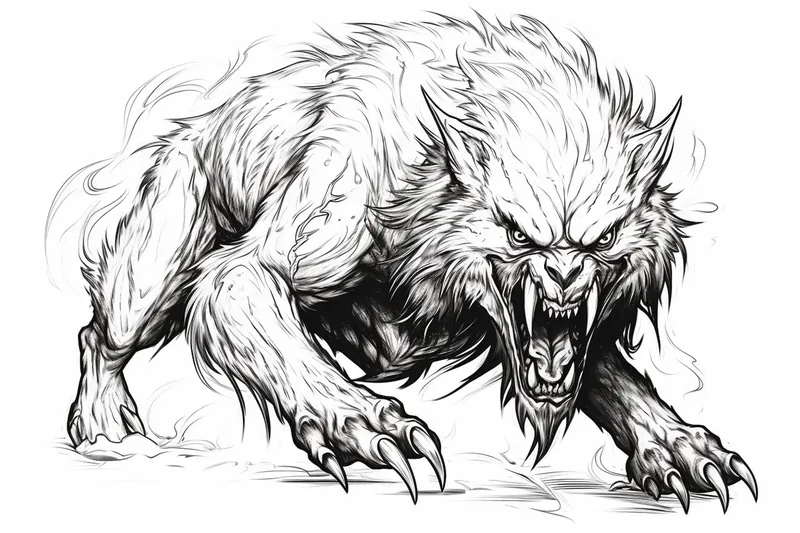
Materials You'll Need
- Pencil
- Paper
- Eraser
With their powerful and fearsome presence, werewolves have captivated our imagination for centuries. Whether it's for a spooky Halloween illustration or simply to showcase your artistic talent, learning how to draw a werewolf can be an exciting and rewarding endeavor. In this step-by-step guide, I will walk you through the process of creating a captivating werewolf drawing. So, grab your pencils and let's get started!
Tip: When drawing your werewolf, pay careful attention to the anatomy and proportions of the ears, as they are crucial for achieving a realistic look. Ensure they are larger and more pronounced, sitting higher on the head, and blend seamlessly with the fur. Studying references of real wolves can help you understand the size and placement relative to the rest of the facial features, enhancing the overall authenticity of your drawing.
Materials Needed
Before we begin, gather the following materials:
- A blank sheet of paper
- Pencils of different lead darkness (2H, HB, 2B, 4B, and 6B)
- An eraser
- Optional: Colored pencils or markers for adding color to your werewolf drawing
Now that you have everything you need, let's dive into the step-by-step process of drawing a werewolf.
Step 1: Outlining the Head
Start by sketching a rough circle at the center of the page. This will serve as the basic outline for the werewolf's head. Next, draw two intersecting lines within the circle, one vertical and one horizontal. These guidelines will help you position the facial features accurately.
Step 2: Shaping the Face
Using the guidelines as a reference, sketch the shape of the werewolf's face. Focus on creating a strong and angular jawline, as this will add to the intimidating nature of your drawing. Don't forget to include pointed ears on the top sides of the head.
Step 3: Adding the Eyes
Place the werewolf's eyes just above the horizontal guideline. Draw them as angular shapes with sharp corners, giving them an intense and piercing gaze. Add the pupils by drawing small circles within the eyes and shade them in to add depth.
Step 4: Detailing the Nose and Mouth
Position the werewolf's nose just below the eyes, in the center of the face. Shape the nose as a slightly curved line with pointed ends. Directly below the nose, draw a wide and menacing mouth, complete with sharp teeth. Add some fur texture around the mouth area to emphasize the creature's wild nature.
Step 5: Drawing the Fur
Now it's time to add the werewolf's fur. Start by sketching short, quick strokes around the outer edge of the head. Gradually increase the length and darkness of the strokes as you move toward the center, creating a sense of depth and volume. Experimenting with different pencil leads to achieving the desired effect.
Step 6: Crafting the Body
Extend two lines from the bottom of the head to create the werewolf's neck. Next, draw the broad shoulders and chest, giving the creature a strong and muscular appearance. Connect the chest to the head with a curved line to form the neck. Make sure to add some fur texture to the chest area as well.
Step 7: Adding Arms and Claws
Sketch out the werewolf's arms, making them muscular and slightly elongated to enhance the sense of power. Add sharp claws to the hands, which can be indicated by drawing curved lines with pointed ends at the fingertips. Don't forget to include fur details on the arms and hands for consistency.
Step 8: Forming the Legs and Feet
Draw the upper leg bones by extending two lines down from the bottom of the body. Connect these lines with a rounded shape to form the werewolf's thigh. Repeat the process for the other leg as well. For the lower legs, create similar bone structures but make them slightly thinner and more tapered towards the feet. Finally, draw the feet with clawed toes.
Step 9: Refining the Details
Take a moment to review your werewolf drawing and make any necessary adjustments. Pay attention to proportions, ensuring that limbs and features are correctly sized in relation to each other. Erase any unnecessary guidelines and clean up the drawing by darkening the desired lines.
Step 10: Optional Coloring
If you want to add color to your werewolf drawing, grab your colored pencils or markers. Select shades of brown, gray, and black to depict the werewolf's fur realistically. Gradually build up the color, layering different shades to achieve depth and dimension. Remember to leave some white areas for highlights.
Final Thoughts on How to Draw a Werewolf
Great job! You have successfully learned how to draw a captivating werewolf. You can create your frightening creature by following these step-by-step instructions and using your artistic skills. Remember to practice regularly; repetition is key to improving your drawing abilities. Now, grab your materials and let your imagination run wild as you create your own werewolf illustrations.
Gallery of Werewolf Drawings
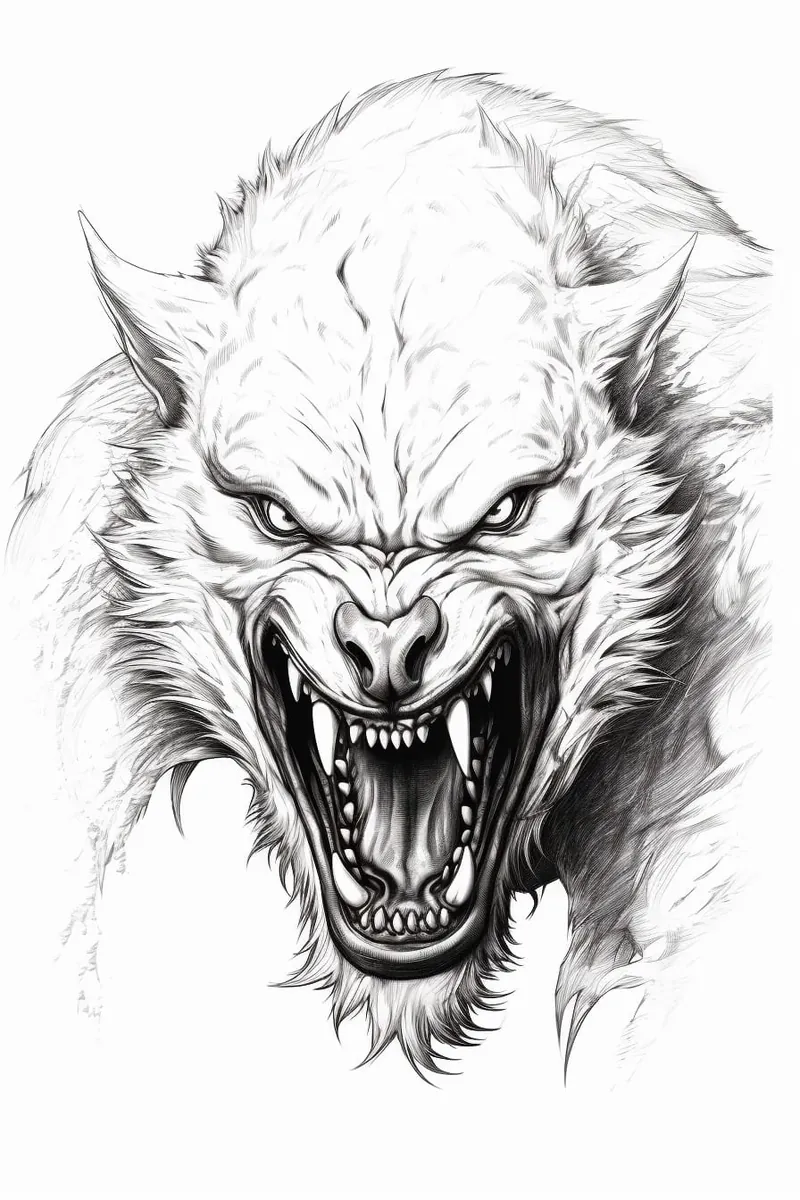
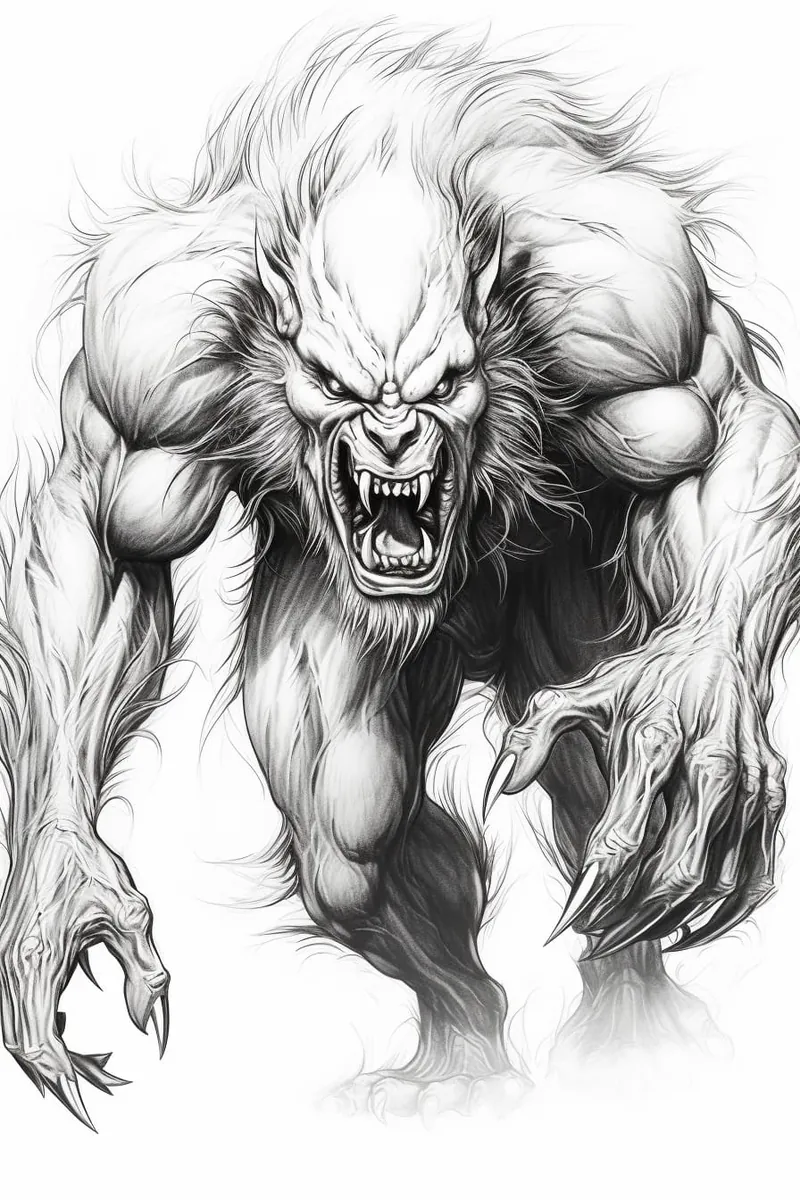
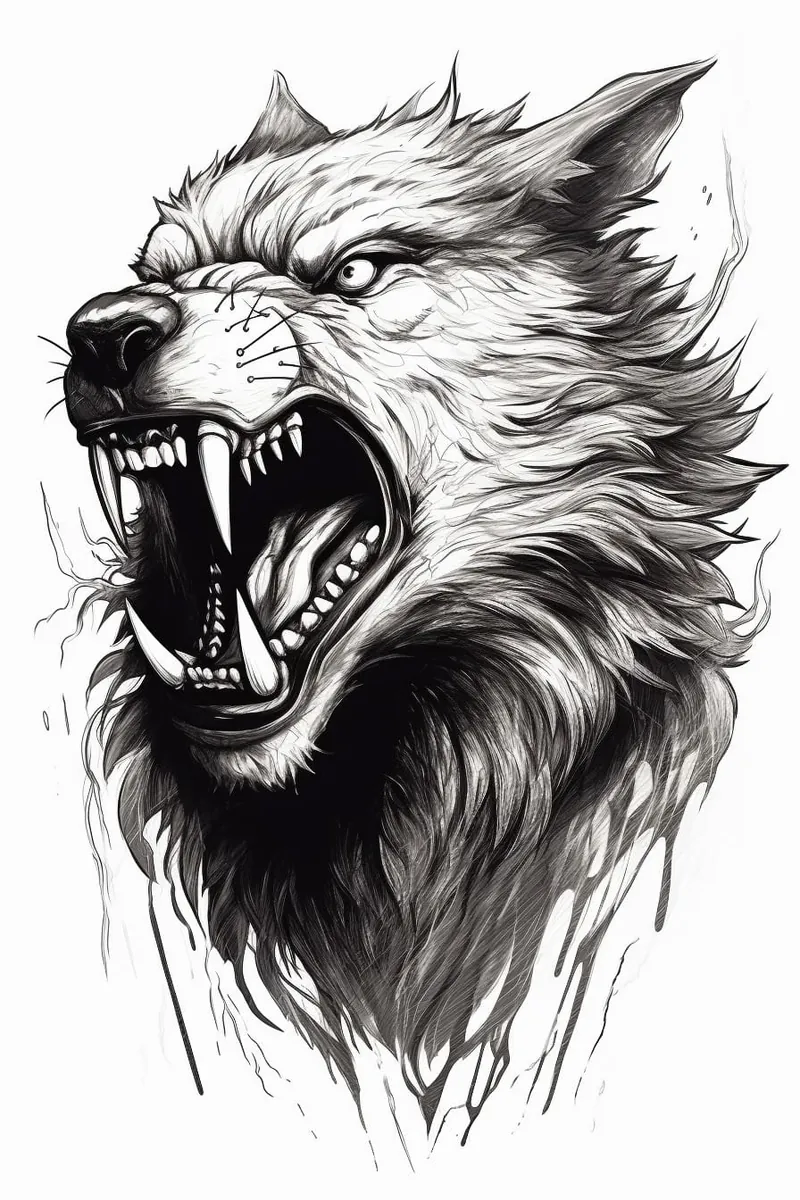
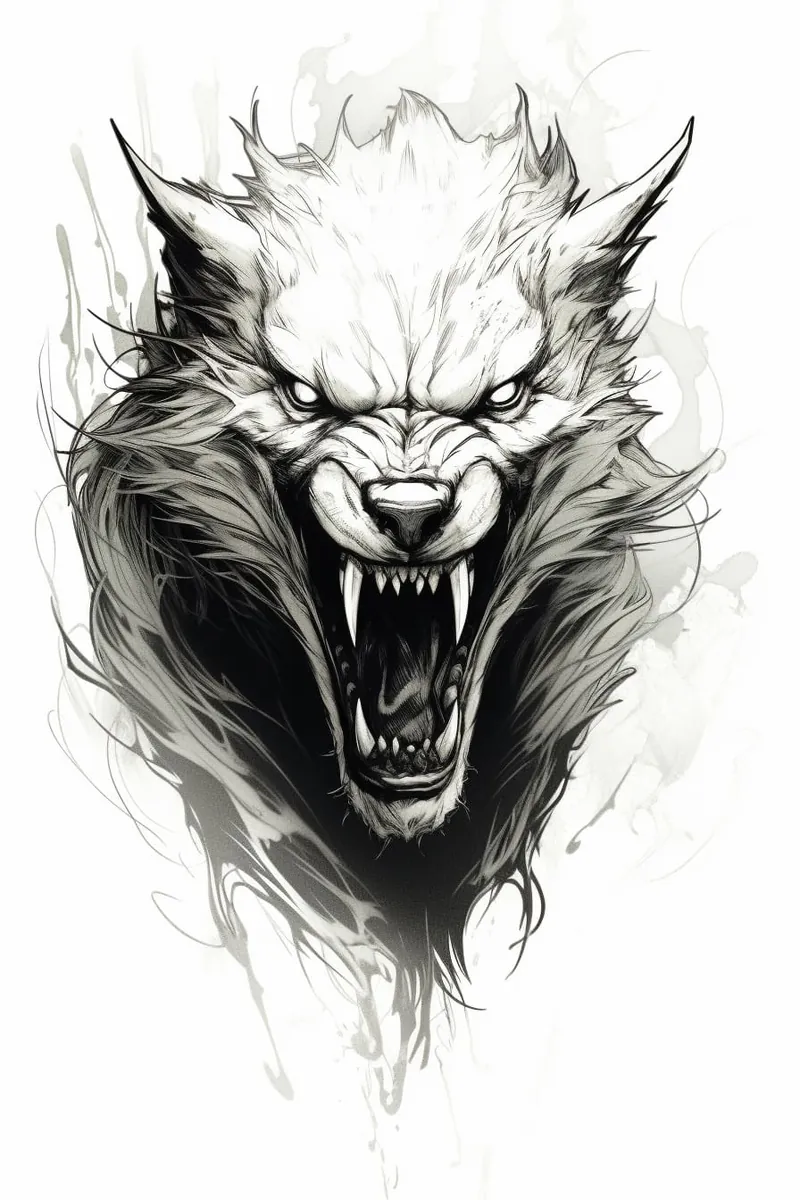
Some Werewolf Drawing Ideas
Stuck for ideas on what to have your werewolf doing? Here are some suggestions for settings and actions for great and memorable werewolf drawings.
1. Forest Under the Full Moon
A classic setting for a werewolf, the dense forest illuminated by the eerie glow of the full moon creates an atmospheric backdrop. You could show the werewolf emerging from the shadows, its fur catching the moonlight, with trees framing the scene. This setting emphasizes the primal connection between the werewolf and nature.
2. Urban Rooftop Chase
Set your werewolf in a modern city, perhaps mid-transformation, leaping across rooftops in pursuit of prey or fleeing from pursuers. The contrast between the beast's primal form and the sleek urban environment adds tension and highlights the werewolf's agility.
3. Transformation Sequence
Capture the werewolf in various stages of transformation from human to beast. This could take place anywhere, but a dark alley or an isolated cabin could intensify the drama. You can play with body contortions, showing muscles bulging and fur growing as the transformation reaches its peak.
4. Werewolf Pack in Battle
Imagine a fierce werewolf pack engaged in battle with another supernatural force, like vampires or rival werewolves. The setting could be a ruined castle or a mist-covered battlefield. This action-heavy scene can show raw power, fury, and the loyalty of the pack.
5. A Werewolf Stalking Prey
This idea places the werewolf in the role of the hunter. Set the scene in a misty moor or a small, secluded village. The werewolf is low to the ground, eyes glowing in the dark, silently tracking its prey. This setting emphasizes suspense and the predatory nature of the creature.
6. Werewolf Among Humans at a Carnival
Set in a busy carnival, you can show the werewolf blending in with humans, perhaps moments before transforming. The contrast between the lively, colorful environment and the lurking danger of a werewolf about to emerge creates suspense. The colorful lights can cast eerie shadows across the scene.
7. Werewolf Howling on a Cliff
A lone werewolf standing atop a high cliff, silhouetted against a massive full moon, can make for a powerful, almost iconic image. This pose emphasizes the werewolf's connection to the wild and the moon, with the vast landscape below adding to the sense of isolation or dominance.
8. Werewolf in Combat with a Knight
Set in a medieval village or castle, this idea portrays a werewolf locked in combat with an armored knight. The knight's polished metal armor contrasts with the werewolf's fur and claws, offering a dynamic clash of raw strength versus skilled weaponry. You can focus on the intensity of the battle and the werewolf's ferocity.
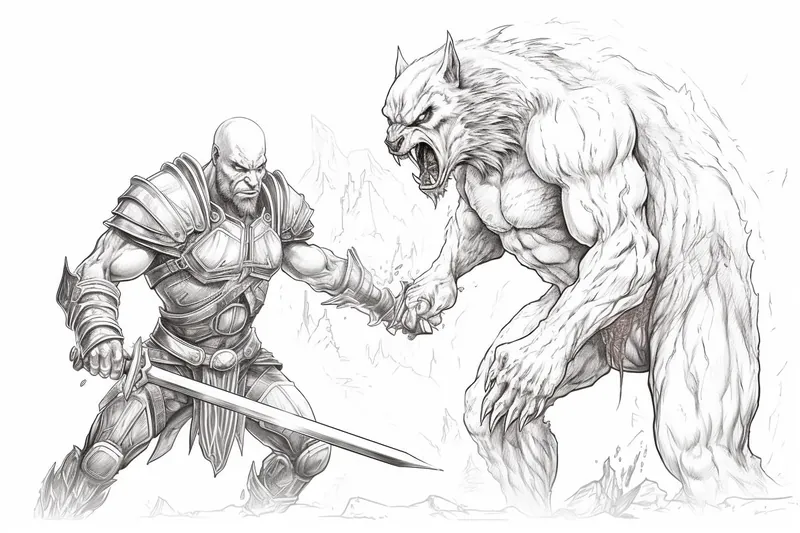
9. Werewolf Protecting its Territory
In a dark forest clearing, a werewolf stands guard over its territory, perhaps protecting a den or warning off intruders. This scene can show the werewolf in a more defensive, even protective posture, with aggressive body language, snarling, and eyes fixed on a perceived threat.
10. Werewolf in Snowy Mountains
Imagine a werewolf trudging through a snowstorm or stalking prey in a barren, snowy wilderness. The cold, bleak environment contrasts with the werewolf's hot-blooded, feral energy. You can play with footprints in the snow, icy breath, and the sense of isolation in this remote setting.
11. Werewolf Awakening in an Ancient Temple
In a long-forgotten temple, perhaps with ancient ruins and glowing runes, a werewolf awakens from a centuries-old curse. This can be a dramatic moment of rebirth, with crumbling stone and magical light surrounding the emerging creature. It's a great opportunity to add supernatural elements to your drawing.
12. Werewolf During a Solar Eclipse
A unique setting with a celestial twist: the werewolf undergoes a transformation during a rare solar eclipse. The dimming light of the sun and the eerie glow of the eclipse can add an otherworldly effect to the scene, while the werewolf's transformation can be more intense or unusual due to the cosmic event.
13. Werewolf in Chains
In a dungeon or a laboratory, you could depict a werewolf bound in heavy chains, perhaps captured by humans or scientists. The werewolf could be straining against its bonds, with muscles bulging and teeth bared, showing both strength and desperation.
14. Werewolf Protecting a Human
In a forest or remote area, a werewolf is in a protective stance, shielding a human from a dangerous threat. This could show the more loyal, guardian-like side of the werewolf, emphasizing the bond between the creature and a person. The werewolf's posture could be defensive, teeth bared, as the danger looms in the background.
Mistake Alert: A common mistake many beginners make when drawing a werewolf is neglecting the anatomy of the ears, which can end up looking too small or oddly shaped compared to the rest of the head. This often happens because artists focus heavily on the facial features and fur details without considering how the ears should proportionally relate to the facial structure. To correct this, take a moment to study references of both wolves and werewolves to understand the size and placement of the ears in relation to the head. Remember, werewolves typically have larger, more pronounced ears that sit higher up on the head; sketch them with a slight tilt and ensure they blend seamlessly into the fur for a more realistic appearance.
15. Werewolf at Dawn
Instead of focusing on the full moon, this setting portrays the aftermath, with a werewolf returning to human form as the sun rises. The transformation could be slow, with the werewolf looking exhausted or injured, surrounded by the aftermath of the night's chaos—perhaps a destroyed village or forest.
These settings and actions can help create powerful, imaginative illustrations that capture the wild, fearsome nature of werewolves in various scenarios. Feel free to mix and match these ideas to develop unique compositions!